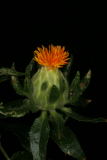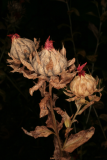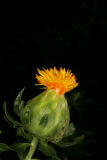Additional notes (click to expand)
Medicinal
Culpeper makes no mention of it in his early works, but later editions (1826) have the following: ‘Wild Saffon, or Saf-flower ... accounted a pretty strong cathartic, evacuating tough viscid phlegm, both upwards and downwards, and by that means is said to clear the lungs, and help the phthisic. It is likewise serviceable against the jaundice; although pretty much out of use.’
Culpeper, Nicholas. (1826). Complete Herbal & English Physician, Magna Books. Facsimile 1826 ed.
Medicinal uses
Uses supported by clinical data
None.
Uses described in pharmacopoeias and well established documents
Treatment of amenorrhoea, dysmenorrhoea and wounds or sores with
pain and swelling, and prevention of atherosclerosis (3, 19).
Uses described in traditional medicine
As an antipyretic, antidiarrhoeal, contraceptive, diaphoretic, emmenagogue,
expectorant, laxative, sedative and stimulant (8, 20, 21). Treatment
of bronchitis, boils, haemorrhoids, respiratory tract infections, ringworm
and scabies (8, 20).
Contraindications
Owing to its traditional use as an emmenagogue and its stimulatory
effects on the uterus, Flos Carthami should not be administered during
pregnancy. Flos Carthami is also contraindicated in haemorrhagic diseases,
peptic ulcers and excessive menstruation (19).
WHO Monographs on Selected Medicinal Plants. Vol. 3, 2007
Nomenclature
Wild Saffon, or Saf-flower
Culpeper, Nicholas. (1826). Complete Herbal & English Physician, Magna Books. Facsimile 1826 ed.
Other use
Notes: Safflower oil is used for cooking; making margarine, and as a substitute for linseed oil in making up paints where the yellow colour of the latter would spoil the paint. Recently genetically modified plants have been produced that synthesise insulin. It is used to produce a dye, and cloth dyed with safflower was found in the tombs of the Pharaohs, dating back to 2,000 BC, including the tomb of King Tutankhamen. The dye is also used in foodstuffs. 600,000 tons a year are produced worldwide for the production of margarine.
Oakeley, Dr. H. F. . (2013). The Gardens of the Pharmacopoeia Londinensis.
link
Carthamus tinctorius L. Asteraceae. Safe Flower, False Saffron - Distribution: W. Asia. Dioscorides (in Beck, 2003) notes the seeds as a purgative, but also advises it made up with 30 figs, which must have helped. Gerard (1640) calls it Atractylis flore luteo the yellow distaffe thistle. and follows Dioscorides in its uses, but does get the reader confused with Cnicus benedictus, calling both plants 'wild bastard saffron'. Culpeper makes no mention of it in his early works, but later (1826) have the following: ‘Wild Saffon, or Saf-flower ... accounted a pretty strong cathartic [causing diarrhoea and vomiting], evacuating tough viscid phlegm, both upwards and downwards, and by that means is said to clear the lungs, and help the phthisic [now equated with tuberculosis]. It is likewise serviceable against the jaundice; although pretty much out of use.’ Linnaeus (1782) noted its use for astma, dropsy, icterus and 'Tussus senilis' , which is probably an old cough. Safflower oil is used for cooking; making margarine, and as a substitute for linseed oil in making up paints where the yellow colour of the latter would spoil the paint. Recently transgenic plants have been produced that synthesise human insulin. It is used to produce a dye, and cloth dyed with safflower was found in the tombs of the Pharaohs, dating back to 2,000 BC, including the tomb of King Tutankhamen. The dye is also used in foodstuffs. 600,000 tons a year are produced worldwide for the production of margarine.
Oakeley, Dr. Henry F. (2013). Wellcome Library notes.
link
Carthamus tinctorius L.
Family: ASTERACEAEGenus: Carthamus
Species: tinctorius L.
Common names: False Saffron; Safflower; Dyer's Saffron
Pharmacopoeia Londinensis name: Carthamum
Distribution summary: West Asia
Habit: Annual
Garden status: Not currently grown
Reason for growing: Medicinal, other use



.JPG)